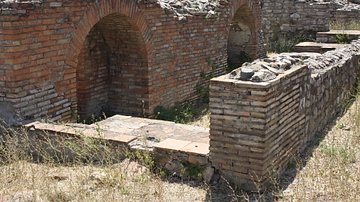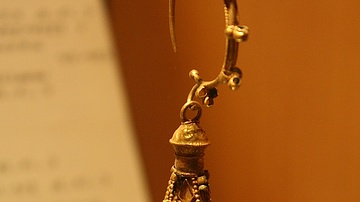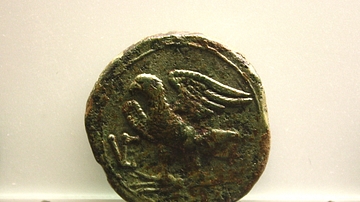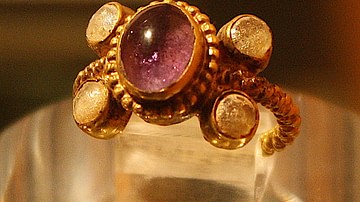Search Images
Browse Content (p. 1270)

Image
Ovens, Roman Baths, Venusia
The remains of the ovens of the Roman baths at Venusia (modern Venosa), southern Italy. 2nd-3rd century CE.

Image
Gold Pendant Earring, Venusia
A gold pendant earring with filigree decoration. Venusia, southern Italy, VII century CE.(Archaeological Museum of Venosa, Italy)

Image
Bronze Coin, Venusia
A Roman bronze coin of Venusia (modern Venosa), southern Italy. Eagle grasping three arrows and VE inscription. (Archaeological Museum of Venosa, Italy)

Image
Gold Filigree Earring, Herakleia
Gold and glass paste pendant earring with filigree and granulation. Acropolis, Herakleia, southern Italy. 1st century BCE. (Archaeological Museum of Siritide, Policoro, Italy)

Image
Gold & Carnelian Ring, Herakleia
A gold and carnelian ring with leaf of life carving. Acropolis, Herakleia, southern Italy. 1st century BCE. (Archaeological Museum of Siritide, Policoro, Italy)

Image
Gold Cameo Ring, Herakleia
A gold cameo ring depicting Aphrodite and Eros. Acropolis of Herakleia, southern Italy. 1st century BCE. (Archaeological Museum of Siritide, Policoro, Italy)

Image
Gold & Glass Paste Earrings, Herakleia
Gold and glass paste earrings. Acropolis of Herakleia, southern Italy. 1st century BCE. (Archaeological Museum of Siritide, Policoro, Italy)

Image
Gold Bezel Ring, Herakleia
Gold ring with carved red bezel. Tomb 1251, western necropolis, Herakleia, southern Italy. 1st century BCE. (Archaeological Museum of Siritide, Policoro, Italy)

Image
Gold Earrings, Herakleia
Gold disk earrings with filigree decoration. Tomb 22, southern necropolis, Herakleia, southern Italy. 4th century BCE. (Archaeological Museum of Siritide, Policoro, Italy)

Image
Amethyst Ring, Venusia
Amethyst, glass paste and gold ring. 6th-7th century CE.
Archaeological Museum of Venosa, Italy.